The Coupling Mechanism between Railway Alignment Design and Resource Environment in the Southwestern Mountainous Areas of China
Abstract
:1. Introduction
1.1. Background
1.2. Literature Review
1.3. Highlights and Organization of the Paper
2. Materials and Methods
2.1. Theoretical Framework
2.2. The Interactive Impact Mechanism of the “Alignment Design–Resource Environment” Complex
2.3. Overview of the Research Area
2.4. Data Sources and Processing
2.4.1. Data Source
2.4.2. Data Processing
2.5. Deviation Coefficient Coupling Degree Model
2.5.1. Deviation Coefficient Coordination Degree Model
2.5.2. Coupling Degree
2.6. “Alignment Design–Resource Environment” Coupling Mechanism
2.7. Relative Degree of Development Model
2.8. Obstacle Degree Model
3. Results
3.1. Analysis of the Degree of Coodination and the Degree of Coupling in the System Layer (U-L)
3.2. Analysis of the Degree of Coodination and the Degree of Coupling in the Element Layer ()
3.3. Analysis of the Degree of Coodination and the Degree of Coupling in the Indicator Layer ()
3.4. Analysis of Driving Factors for the Collaborative Development of U-L
4. Discussion
5. Conclusions
Author Contributions
Funding
Institutional Review Board Statement
Informed Consent Statement
Data Availability Statement
Conflicts of Interest
References
- Zhang, D.; Sun, Z.; Fang, Q. Scientific problems and research proposals for Sichuan–Tibet railway tunnel construction. Undergr. Space 2022, 7, 419–439. [Google Scholar] [CrossRef]
- Xu, B.; Li, J.; Luo, Z.; Wu, J.; Liu, Y.; Yang, H.; Pei, X. Analyzing the spatiotemporal vegetation dynamics and their responses to climate change along the Ya’an–Linzhi section of the Sichuan–Tibet railway. Remote Sens. 2022, 14, 3584. [Google Scholar] [CrossRef]
- Cui, P.; Ge, Y.; Li, S.; Li, Z.; Xu, X.; Zhou, G.G.D.; Chen, H.; Wang, H.; Lei, Y.; Zhou, L.; et al. Scientific challenges in disaster risk reduction for the Sichuan–Tibet railway. Eng. Geol. 2022, 309, 106837. [Google Scholar] [CrossRef]
- Wan, X.; Pu, H.; Schonfeld, P.; Song, T.; Li, W.; Peng, L.; Hu, J.; Zhang, M. Mountain railway alignment optimization based on landform recognition and presetting of dominating structures. Comput.-Aided Civ. Inf. 2023, 39, 242–263. [Google Scholar] [CrossRef]
- Song, T.; Pu, H.; Schonfeld, P.; Liang, Z.; Zhang, M.; Hu, J.; Zhou, Y.; Xu, Z. Mountain railway alignment optimization integrating layouts of large-scale auxiliary construction projects. Comput.-Aided Civ. Inf. 2022, 38, 433–453. [Google Scholar] [CrossRef]
- Song, T.; Pu, H.; Schonfeld, P.; Zhang, H.; Li, W.; Hu, J.; Wang, J. Mountain railway alignment optimization considering geological impacts: A cost-hazard bi-objective model. Comput.-Aided Civ. Inf. 2020, 35, 1365–1386. [Google Scholar] [CrossRef]
- Deng, T.; Sharafat, A.; Wie, Y.M.; Lee, K.G.; Lee, E.; Lee, K.H. A geospatial analysis-based method for railway route selection in marine glaciers: A case study of the Sichuan-Tibet railway network. Remote Sens. 2023, 15, 4175. [Google Scholar] [CrossRef]
- Song, T.; Pu, H.; Schonfeld, P.; Zhang, H.; Li, W.; Hu, J.; Wang, J.; Wang, J. Bi-objective mountain railway alignment optimization incorporating seismic risk assessment. Comput.-Aided Civ. Inf. 2020, 36, 143–163. [Google Scholar] [CrossRef]
- Song, T.; Pu, H.; Yang, T.Y.; Schonfeld, P.; Li, W.; Hu, J. Optimizing net present values of risk avoidance for mountain railway alignments with seismic performance evaluation. Comput.-Aided Civ. Inf. 2023, 39, 944–962. [Google Scholar] [CrossRef]
- Liu, W.; Yang, X.; Gao, X.; Zeng, S.; Zhou, J.; Wu, X.; Zhang, J. Impacts of water surge from mountain railroad tunnels on ecological environments based on the RSEI model. Environ. Sci. Pollut. Res. 2023, 30, 120400–120421. [Google Scholar] [CrossRef]
- Chen, Y.; Zhang, T.; Zhou, X.; Li, J.; Yi, G.; Bie, X.; Hu, J.; Wen, B. Ecological sensitivity and its driving factors in the area along the Sichuan–Tibet railway. Environ. Dev. Sustain. 2023, 1–20. [Google Scholar] [CrossRef]
- Pu, H.; Cai, L.; Song, T.; Schonfeld, P.; Hu, J. Minimizing costs and carbon emissions in railway alignment optimization: A bi-objective model. Transport. Res. D-Tr. E. 2023, 116, 103615. [Google Scholar] [CrossRef]
- Zhang, H.; Pu, H.; Schonfeld, P.; Song, T.; Li, W.; Wang, J.; Peng, X.; Hu, J. Multi-objective railway alignment optimization considering costs and environmental impacts. Appl. Soft Comput. 2020, 89, 106105. [Google Scholar] [CrossRef]
- Chen, Z.; Chang, R.; Pei, X.; Yu, Z.; Guo, H.; He, Z.; Zhao, W.; Zhang, Q.; Chen, Y. Tunnel geothermal disaster susceptibility evaluation based on interpretable ensemble learning: A case study in Ya’an–Changdu section of the Sichuan–Tibet traffic corridor. Eng. Geol. 2023, 313, 106985. [Google Scholar] [CrossRef]
- Owais, M.; Ahmed, A.S.; Moussa, G.S.; Khalil, A.A. An optimal metro design for transit networks in existing square cities based on non-demand criterion. Sustainability 2020, 12, 9566. [Google Scholar] [CrossRef]
- Owais, M.; Ahmed, A.S. Frequency based transit assignment models: Graph formulation study. IEEE Access 2022, 10, 62991–63003. [Google Scholar] [CrossRef]
- Owais, M.; Ahmed, A.S.; Moussa, G.S.; Khalil, A.A. Design scheme of multiple-subway lines for minimizing passengers transfers in mega-cities transit networks. Int. J. Rail Transp. 2021, 9, 540–563. [Google Scholar] [CrossRef]
- Huang, D.; Wen, F.; Li, G.; Wang, Y. Coupled development of the urban water-energy-food nexus: A systematic analysis of two megacities in China’s Beijing-Tianjin-Hebei area. J. Clean. Prod. 2023, 419, 138051. [Google Scholar] [CrossRef]
- Li, C.Z.; Tam, V.W.Y.; Zhou, M.; Liu, L.; Wu, H. Quantifying the coupling coordination effect between the prefabricated building industry and its external comprehensive environment in China. J. Clean. Prod. 2024, 434, 140238. [Google Scholar] [CrossRef]
- Gao, T.; Li, Z.; Gao, Y.; Schonfeld, P.; Feng, X.; Wang, Q.; He, Q. A deep reinforcement learning approach to mountain railway alignment optimization. Comput.-Aided Civ. Inf. 2021, 37, 73–92. [Google Scholar] [CrossRef]
- Gao, Y.; Zhang, T.; Zhu, C.; Yang, S.; Schonfeld, P.; Zou, K.; Zhang, J.; Zhu, Y.; Wang, P.; He, Q. Biobjective optimization for railway alignment fine-grained designs with parallel existing railways. Comput.-Aided Civ. Inf. 2024, 39, 438–457. [Google Scholar] [CrossRef]
- He, Q.; Gao, T.; Gao, Y.; Li, H.; Schonfeld, P.; Zhu, Y.; Li, Q.; Wang, P. A bi-objective deep reinforcement learning approach for low-carbon-emission high-speed railway alignment design. Transport. Res. C-Emer. 2023, 147, 104006. [Google Scholar] [CrossRef]
- Song, T.; Pu, H.; Schonfeld, P.; Zhang, H.; Li, W.; Peng, X.; Hu, J.; Liu, W. GIS-based multi-criteria railway design with spatial environmental considerations. Appl. Geogr. 2021, 131, 102449. [Google Scholar] [CrossRef]
- TB 10501-2016; Railway Engineering Environmental Protection Design Specification. China Railway Publishing House: Beijing, China, 2016.
- TB 10504-2007; Preparation Methods of Feasibility Study and Design Documents for Pre-Feasibility Study of Railway Construction Projects. China Railway Publishing House: Beijing, China, 2007.
- Ren, J.; Xu, X.; Lv, Y.; Wang, Q.; Li, A.; Li, K.; Zhu, J.; Cai, J.; Liu, S. Late quaternary slip rate of the northern Lancangjiang fault zone in eastern Tibet: Seismic hazards for the Sichuan-Tibet railway and regional tectonic implications. Eng. Geol. 2022, 306, 106748. [Google Scholar] [CrossRef]
- Xie, S.; Zhang, X.; Pang, Y. Wind dynamic characteristics and wind tunnel simulation of subgrade sand hazard in the Shannan wide valley of the Sichuan–Tibet railway. Int. J. Environ. Res. Public Health 2022, 19, 8341. [Google Scholar] [CrossRef] [PubMed]
- Behboudian, M.; Anamaghi, S.; Mahjouri, N.; Kerachian, R. Enhancing the resilience of ecosystem services under extreme events in socio-hydrological systems: A spatio-temporal analysis. J. Clean. Prod. 2023, 397, 136437. [Google Scholar] [CrossRef]
- Ashofteh, P.-S.; Pourali Dougaheh, M. Ranking the optimal combination of low-impact urban development systems under climate change with the TODIM multi-criteria decision-making method. J. Clean. Prod. 2024, 434, 140108. [Google Scholar] [CrossRef]
- Ji, J.; Wang, D. Evaluation analysis and strategy selection in urban flood resilience based on EWM-TOPSIS method and graph model. J. Clean. Prod. 2023, 425, 138955. [Google Scholar] [CrossRef]
- Zhu, C.; Fang, C.; Zhang, L. Analysis of the coupling coordinated development of the Population–Water–Ecology–Economy system in urban agglomerations and obstacle factors discrimination: A case study of the Tianshan North Slope Urban Agglomeration, China. Sustain. Cities Soc. 2023, 90, 104359. [Google Scholar] [CrossRef]
- Bian, D.; Yang, X.; Xiang, W.; Sun, B.; Chen, Y.; Babuna, P.; Li, M.; Yuan, Z. A new model to evaluate water resource spatial equilibrium based on the game theory coupling weight method and the coupling coordination degree. J. Clean. Prod. 2022, 366, 132907. [Google Scholar] [CrossRef]
- Cheng, X.; Long, R.; Chen, H.; Li, Q. Coupling coordination degree and spatial dynamic evolution of a regional green competitiveness system—A case study from China. Ecol. Indic. 2019, 104, 489–500. [Google Scholar] [CrossRef]
- Jiang, L.; Wu, Y.; He, X.; Fu, Q.; Wang, Z.; Jiang, Q. Dynamic simulation and coupling coordination evaluation of water footprint sustainability system in Heilongjiang province, China: A combined system dynamics and coupled coordination degree model. J. Clean. Prod. 2022, 380, 135044. [Google Scholar] [CrossRef]
- Sui, G.; Wang, H.; Cai, S.; Cui, W. Coupling coordination analysis of resources, economy, and ecology in the Yellow River Basin. Ecol. Indic. 2023, 156, 111133. [Google Scholar] [CrossRef]
- Sun, J.; Zhai, N.; Mu, H.; Miao, J.; Li, W.; Li, M. Assessment of urban resilience and subsystem coupling coordination in the Beijing-Tianjin-Hebei urban agglomeration. Sustain. Cities Soc. 2024, 100, 105058. [Google Scholar] [CrossRef]
- Yin, Z.; Tang, Y.; Liu, H.; Dai, L. Coupling coordination relationship between tourism economy-social welfare-ecological environment: Empirical analysis of Western Area, China. Ecol. Indic. 2023, 155, 110938. [Google Scholar] [CrossRef]
- Bian, H.R.; Liu, Y. A deep graph learning-enhanced assessment method for industry-sustainability coupling degree in smart cities. Sustainability 2023, 15, 1226. [Google Scholar] [CrossRef]
- Fan, S.; Liu, G.; Tu, Y.; Zhu, J.; Zhang, P.; Tian, Z. Improved multi-criteria decision-making method integrating machine learning for patent competitive potential Evaluation: A case study in water pollution abatement technology. J. Clean. Prod. 2023, 403, 136896. [Google Scholar] [CrossRef]
- Zhang, R.; Yang, J.; Ma, X.; Xiao, X.; Xia, J. Optimal allocation of local climate zones based on heat vulnerability perspective. Sustain. Cities Soc. 2023, 99, 104981. [Google Scholar] [CrossRef]
- Dong, G.; Ge, Y.; Liu, J.; Kong, X.; Zhai, R. Evaluation of coupling relationship between urbanization and air quality based on improved coupling coordination degree model in Shandong Province, China. Ecol. Indic. 2023, 154, 110578. [Google Scholar] [CrossRef]
- Fang, C.; Cui, X.; Li, G.; Bao, C.; Wang, Z.; Ma, H.; Sun, S.; Liu, H.; Luo, K.; Ren, Y. Modeling regional sustainable development scenarios using the Urbanization and Eco-environment Coupler: Case study of Beijing-Tianjin-Hebei urban agglomeration, China. Sci. Total Environ. 2019, 689, 820–830. [Google Scholar] [CrossRef]
- Wu, S.; Wang, D.; Yan, Z.; Wang, X.; Han, J. Coupling or contradiction? The spatiotemporal relationship between urbanization and urban park system development in China. Ecol. Indic. 2023, 154, 110703. [Google Scholar] [CrossRef]
- Sui, Y.; Hu, J.; Zhang, N.; Ma, F. Exploring the dynamic equilibrium relationship between urbanization and ecological environment—A case study of Shandong Province, China. Ecol. Indic. 2024, 158, 111456. [Google Scholar] [CrossRef]
- Lu, M.; Duan, Y.; Wu, X. Evaluation of the coupling and coordination degree of eco-cultural tourism system in the Jiangsu-Zhejiang-Shanghai-Anhui region. Ecol. Indic. 2023, 156, 111180. [Google Scholar] [CrossRef]

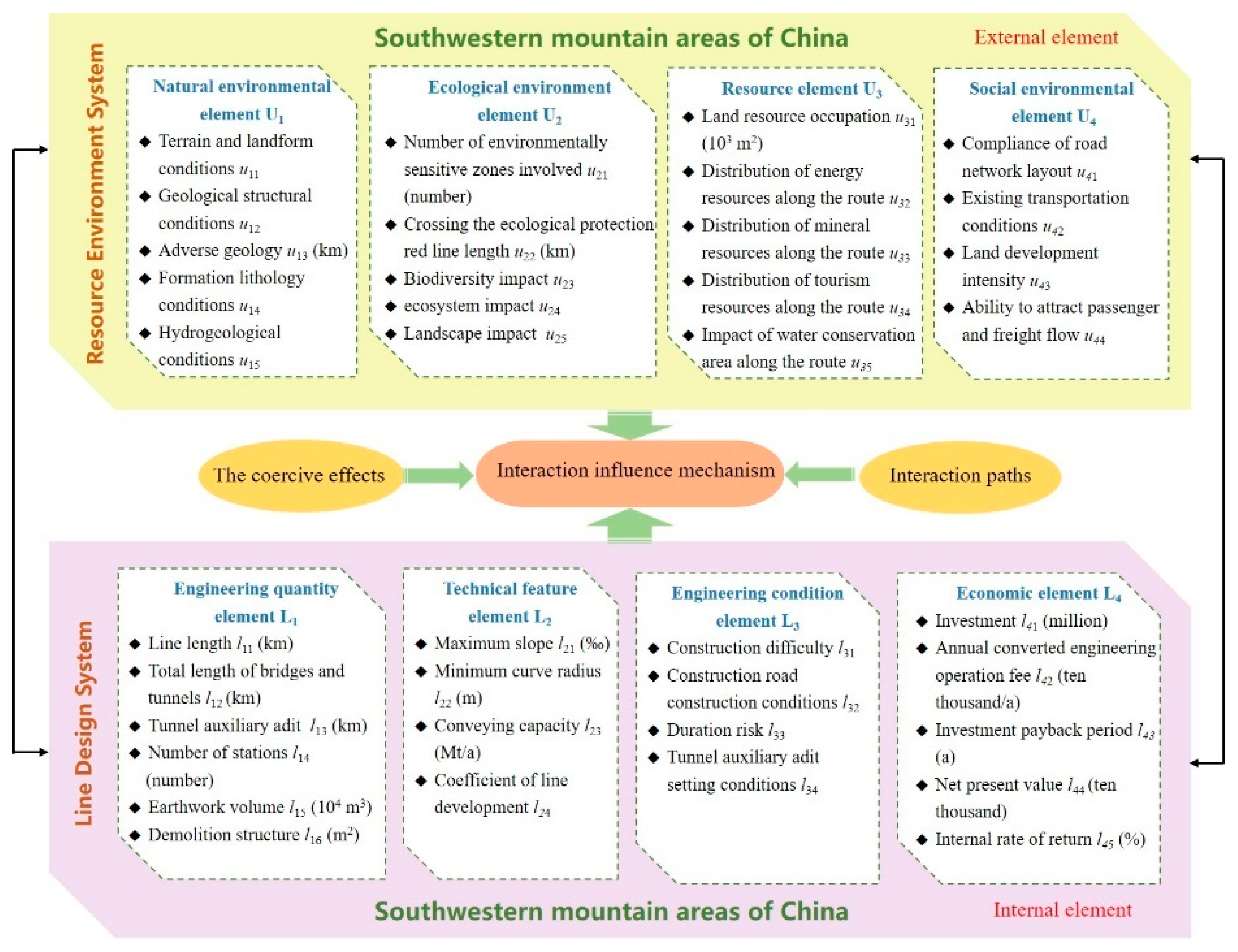
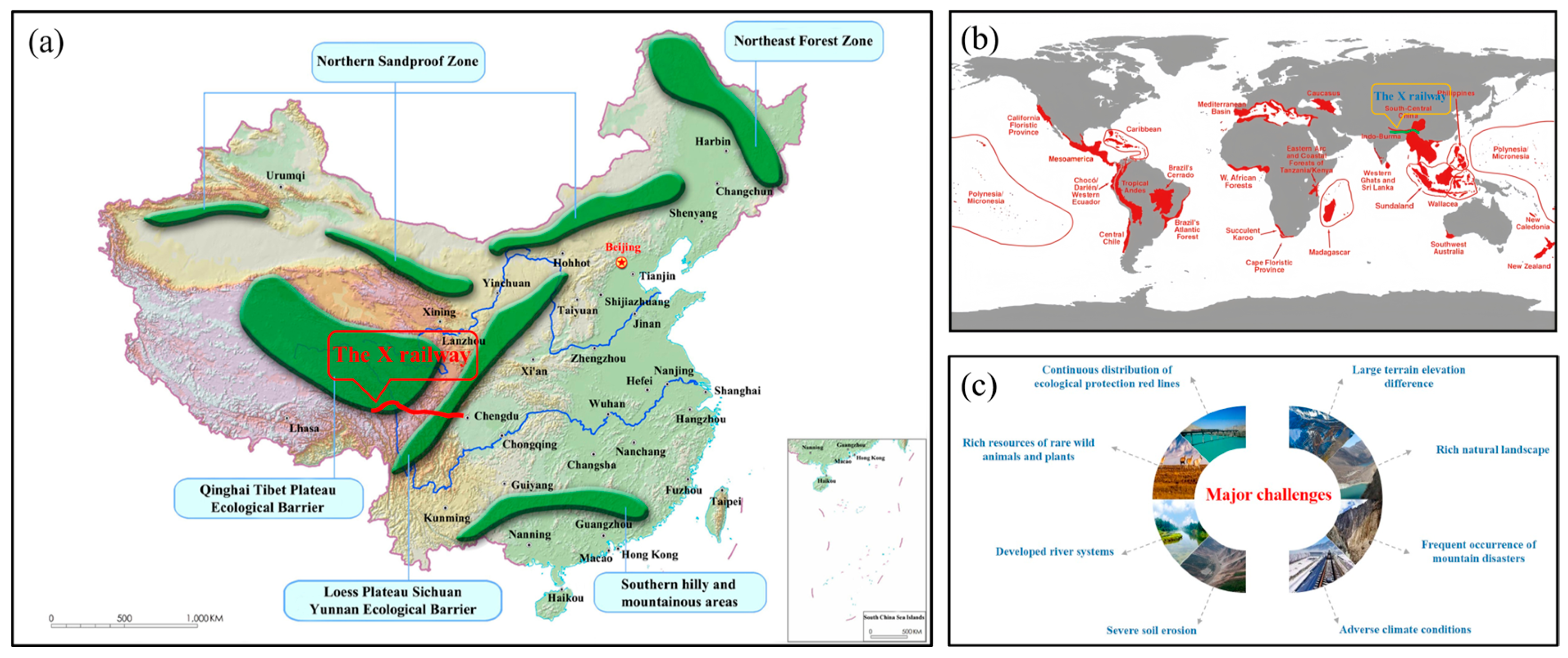

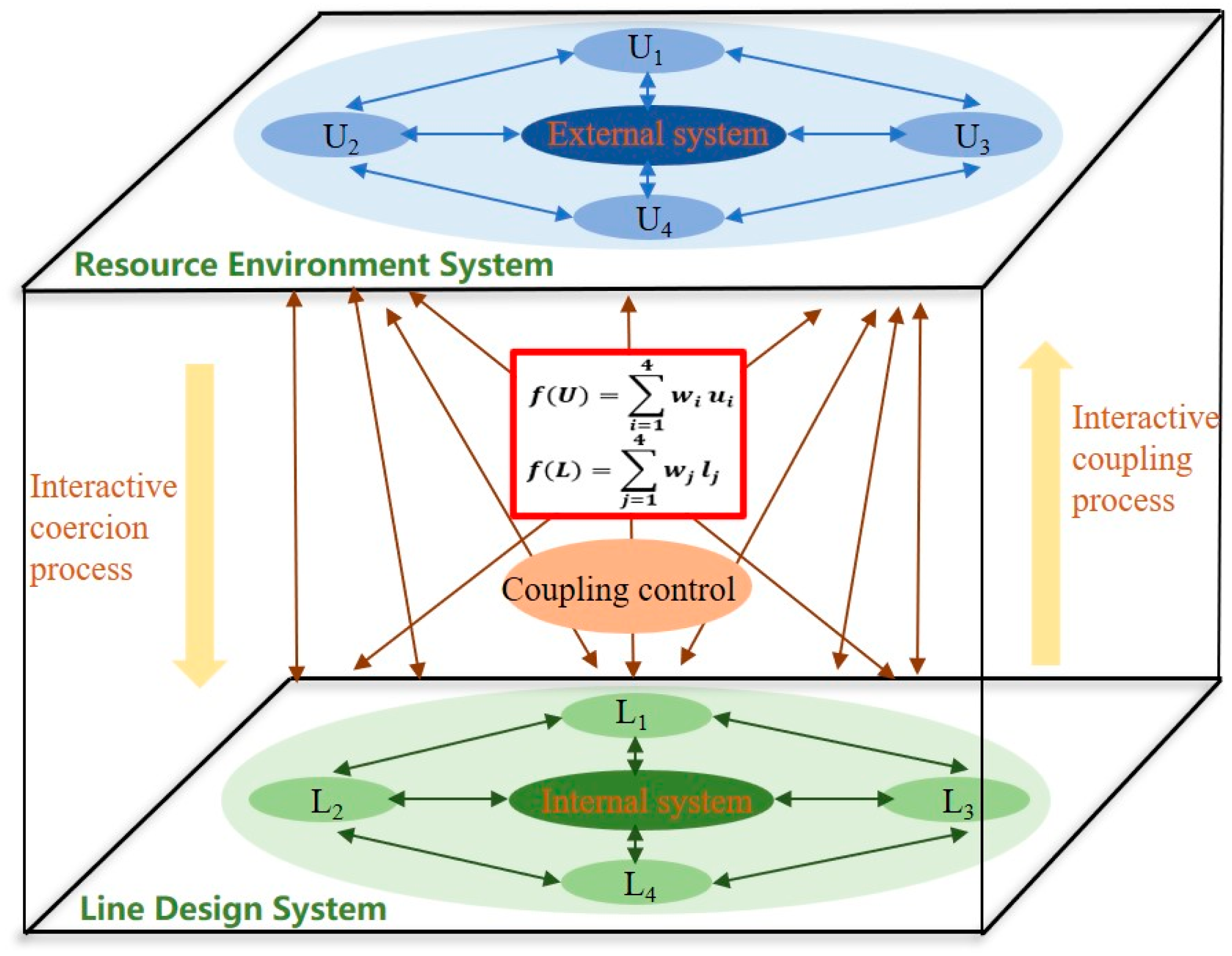


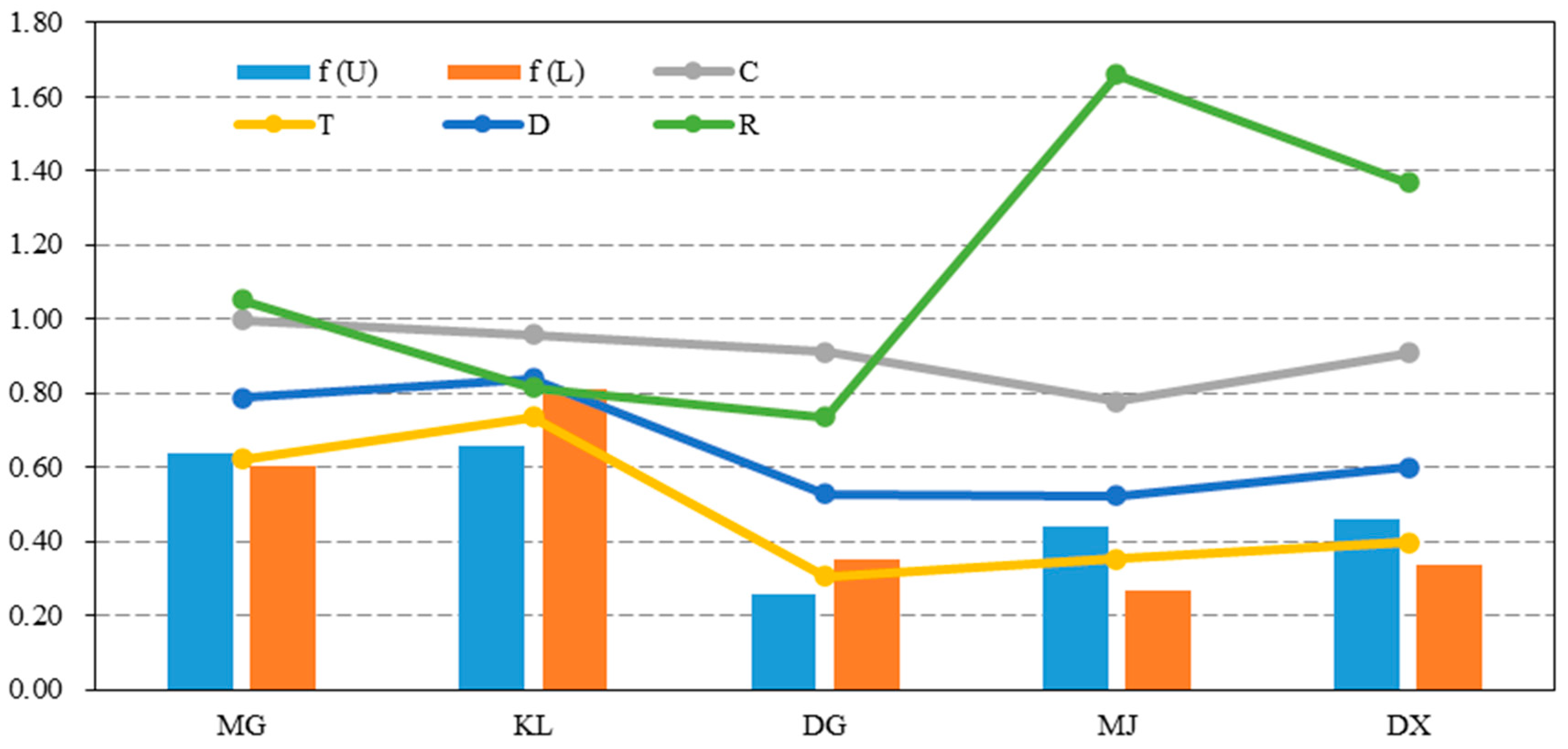


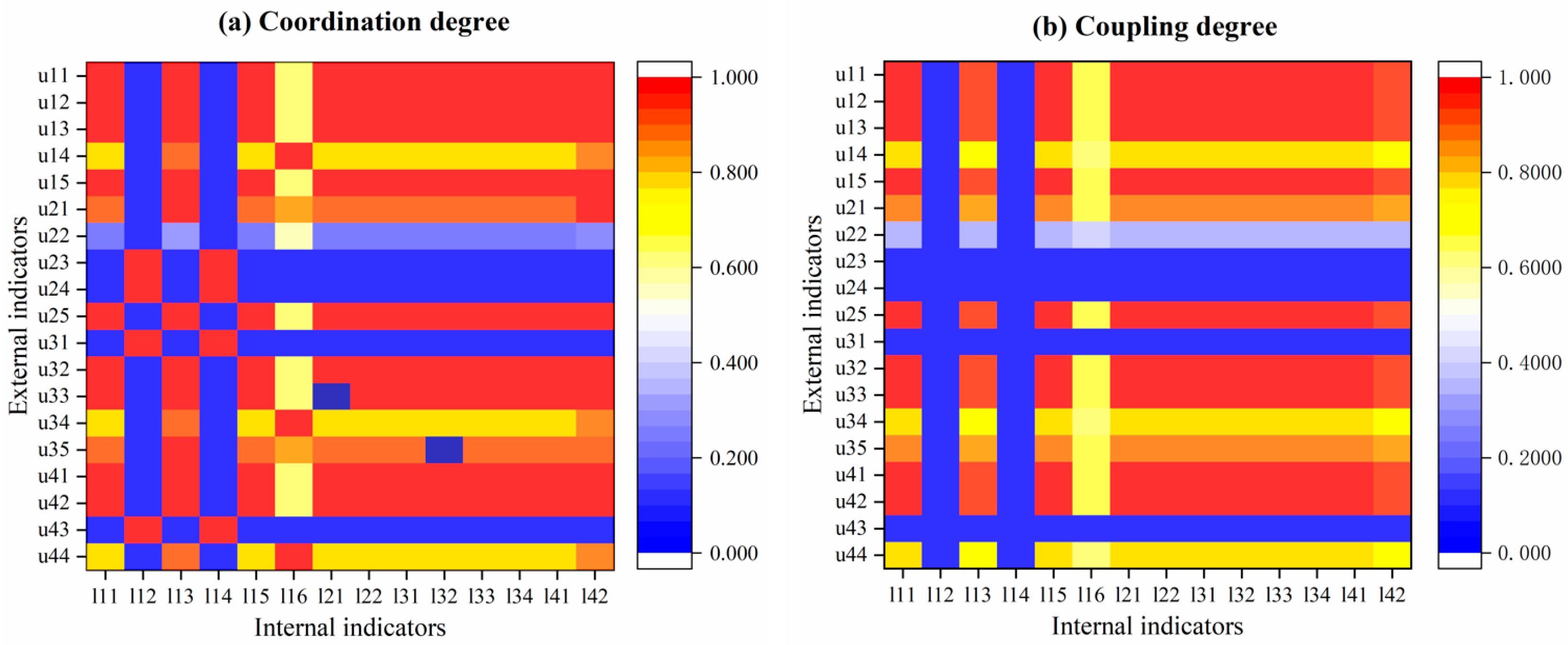

| System Layer | Element Layer | Indicator Layer | Type | Nature | Source |
|---|---|---|---|---|---|
| Resource Environment System | Natural environmental element U1 | Terrain and landform conditions u11 | Qualitative | Positive | Engineering data; Field investigation; References [1,2,20,21,22,23] |
| Geological structural conditions u12 | Qualitative | Positive | |||
| Adverse geology (km) u13 | Qualitative | Negative | |||
| Formation lithology conditions u14 | Qualitative | Positive | |||
| Hydrogeological conditions u15 | Qualitative | Positive | |||
| Ecological environment element U2 | Number of environmentally sensitive zones involved u21 (number) | Quantitative | Negative | ||
| Crossing the ecological protection red line length u22 (km) | Quantitative | Negative | |||
| Biodiversity impact u23 | Qualitative | Positive | |||
| ecosystem impact u24 | Qualitative | Positive | |||
| Landscape impact u25 | Qualitative | Positive | |||
| Resource element U3 | Land resource occupation u31 (103 m2) | Quantitative | Negative | ||
| Distribution of energy resources along the route u32 | Qualitative | Positive | |||
| Distribution of mineral resources along the route u33 | Qualitative | Positive | |||
| Distribution of tourism resources along the route u34 | Qualitative | Positive | |||
| Impact of water conservation area along the route u35 | Qualitative | Positive | |||
| Social environmental element U4 | Compliance of road network layout u41 | Qualitative | Positive | ||
| Existing transportation conditions u42 | Qualitative | Positive | |||
| Land development intensity u43 | Qualitative | Positive | |||
| Ability to attract passenger and freight flow u44 | Qualitative | Positive | |||
| Line Design System | Engineering quantity element L1 | Line length l11 (km) | Quantitative | Negative | |
| Total length of bridges and tunnels l12 (km) | Quantitative | Positive | |||
| Tunnel auxiliary adit l13 (km) | Quantitative | Negative | |||
| Number of stations l14 (number) | Quantitative | Positive | “TB 10501-2016 Railway Engineering Environmental Protection Design Specification”; “Method for Preparation of Feasibility Study and Design Documents for Railway Construction Goals” References [24,25] | ||
| Earthwork volume l15 (104 m3) | Quantitative | Negative | |||
| Demolition structure l16 (m2) | Quantitative | Negative | |||
| Technical feature element L2 | Maximum slope l21 (‰) | Quantitative | Negative | ||
| Minimum curve radius l22 (m) | Quantitative | Positive | |||
| Conveying capacity l23 (Mt/a) | Quantitative | Positive | |||
| Coefficient of line development l24 | Quantitative | Positive | |||
| Engineering condition element L3 | Construction difficulty l31 | Qualitative | Positive | ||
| Construction road constructionconditions l32 | Qualitative | Positive | |||
| Duration risk l33 | Qualitative | Positive | |||
| Tunnel auxiliary adit setting conditions l34 | Qualitative | Positive | |||
| Economic element L4 | Investment l41 (million) | Quantitative | Negative | ||
| Annual converted engineering operation fee l42 (ten thousand/a) | Quantitative | Negative | |||
| Investment payback period l43 (a) | Quantitative | Positive | |||
| Net present value l44 (ten thousand) | Quantitative | Positive | |||
| Internal rate of return l45 (%) | Quantitative | Positive |
| D | Coupling Strength | Coupling Type | R | Coupling Characteristics |
|---|---|---|---|---|
| [0.900,1.000] | Complete coupling | Highly collaborative development | 0 < R ≤ 0.9 | Highly coupled–external system lag type |
| 0.9 < R < 1.1 | Highly coupled–internal and external system synchronous type | |||
| R ≥ 1.1 | Highly coupled–internal system lag type | |||
| [0.800,0.899] | High-quality coupling | High-quality collaborative development | 0 < R ≤ 0.9 | High-quality coupling–external system lag type |
| 0.9 < R < 1.1 | High-quality coupling–internal and external system synchronous type | |||
| R ≥ 1.1 | High-quality coupling–internal system lag type | |||
| [0.700,0.799] | Good coupling | Good collaborative development | 0 < R ≤ 0.9 | Good coupling–external system lag type |
| 0.9 < R < 1.1 | Good coupling–internal and external system synchronous type | |||
| R ≥ 1.1 | Good coupling–internal system lag type | |||
| [0.600,0.699] | Intermediate coupling | Intermediate collaborative development | 0 < R ≤ 0.9 | Intermediate coupling–external system lag type |
| 0.9 < R < 1.1 | Intermediate coupling–internal and external system synchronous type | |||
| R ≥ 1.1 | Intermediate coupling–internal system lag type | |||
| [0.500,0.599] | Primary coupling | Reluctantly collaborative development | 0 < R ≤ 0.9 | Primary coupling–external system hysteresis type |
| 0.9 < R < 1.1 | Primary coupling–internal and external system synchronous type | |||
| R ≥ 1.1 | Primary coupling–internal system lag type | |||
| [0.000,0.499] | Low-level coupling | Imbalanced recessional | 0 < R ≤ 0.9 | Low-level coupling–external system lag type |
| 0.9 < R < 1.1 | Low-level coupling–internal and external system synchronous type | |||
| R ≥ 1.1 | Low-level coupling–internal system lag type |
Disclaimer/Publisher’s Note: The statements, opinions and data contained in all publications are solely those of the individual author(s) and contributor(s) and not of MDPI and/or the editor(s). MDPI and/or the editor(s) disclaim responsibility for any injury to people or property resulting from any ideas, methods, instructions or products referred to in the content. |
© 2024 by the authors. Licensee MDPI, Basel, Switzerland. This article is an open access article distributed under the terms and conditions of the Creative Commons Attribution (CC BY) license (https://creativecommons.org/licenses/by/4.0/).
Share and Cite
Wan, B.; Bao, X.; Li, A. The Coupling Mechanism between Railway Alignment Design and Resource Environment in the Southwestern Mountainous Areas of China. Sustainability 2024, 16, 4572. https://doi.org/10.3390/su16114572
Wan B, Bao X, Li A. The Coupling Mechanism between Railway Alignment Design and Resource Environment in the Southwestern Mountainous Areas of China. Sustainability. 2024; 16(11):4572. https://doi.org/10.3390/su16114572
Chicago/Turabian StyleWan, Bingtong, Xueying Bao, and Aichun Li. 2024. "The Coupling Mechanism between Railway Alignment Design and Resource Environment in the Southwestern Mountainous Areas of China" Sustainability 16, no. 11: 4572. https://doi.org/10.3390/su16114572




